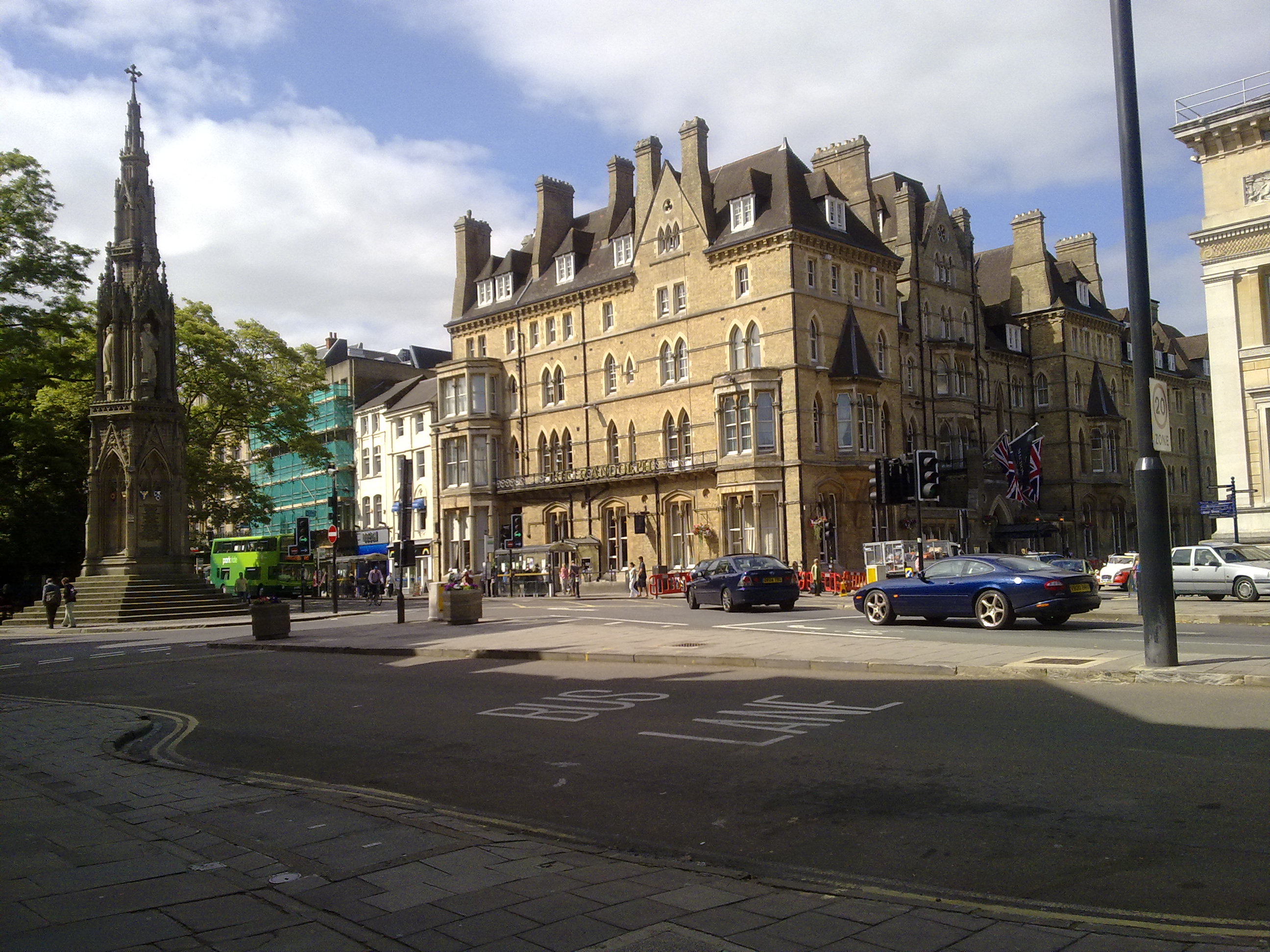|
Shelswell
Shelswell is a hamlet in Oxfordshire about south of Brackley in neighbouring Northamptonshire. Manor Shelswell's toponym comes from Old English and suggests that the settlement may originally have been the well belonging to ''Scield'', a Saxon settler.Lobel, 1959, pages 285-289 The spring that gave rise to this well is no longer traceable. The toponym was ''"Scaldeswelle"'' in 1180 and ''"Saldeywell"'' in 1219 before evolving into the present form. Before the Norman Conquest of England the manor of Shelswell belonged to a Saxon called Edwin, but the Domesday Book records that by 1086 Shelswell had been granted to Geoffrey de Montbray, Bishop of Coutances. In 1093 the Bishop left Shelswell to his nephew Robert de Mowbray, Earl of Northumbria, but in 1095 the Earl was imprisoned and forfeited his estates for rebelling against William Rufus. By the 12th century Robert, 1st Earl of Gloucester, an illegitimate son of Henry I, was Shelswell's feudal overlord. Shelswell remained part ... [...More Info...] [...Related Items...] OR: [Wikipedia] [Google] [Baidu] |
William Wilkinson (architect)
William Wilkinson (1819–1901) was a British Gothic Revival architect who practised in Oxford, England. Family Wilkinson's father was a builder in Witney in Oxfordshire. William's elder brother George Wilkinson (1814–1890) was also an architect, as were William's nephews C.C. Rolfe (died 1907) and H.W. Moore (1850–1915). Career Most of Wilkinson's buildings are in Oxfordshire. His major works include the Randolph Hotel in Oxford, completed in 1864. He was in partnership with his nephew H.W. Moore from 1881. In his long career Wilkinson had a number of pupils, including H.J. Tollit (1835–1904). Works Churches In 1841, at the age of only 22, Wilkinson designed a new Church of England parish church, Holy Trinity at Lew, Oxfordshire. His other work on churches included: *St Leonard's parish church, Eynsham: restoration, 1856 *Witney Cemetery: lodge and two chapels, 1857 *Witney Workhouse: chapel, 1860 *All Saints' parish church, Middleton Cheney, Northamptonshire: ... [...More Info...] [...Related Items...] OR: [Wikipedia] [Google] [Baidu] |
Newton Purcell With Shelswell
Newton Purcell with Shelswell is a civil parish in Oxfordshire, England. It was formed in 1932 by merger of the parishes of Newton Purcell () and Shelswell Shelswell is a hamlet in Oxfordshire about south of Brackley in neighbouring Northamptonshire. Manor Shelswell's toponym comes from Old English and suggests that the settlement may originally have been the well belonging to ''Scield'', a Saxon ...Lobel, 1959, pages 285-289 (). Sources * References Civil parishes in Oxfordshire {{Oxfordshire-geo-stub ... [...More Info...] [...Related Items...] OR: [Wikipedia] [Google] [Baidu] |
Banbury (UK Parliament Constituency)
Banbury, also informally known as Banbury and North Oxfordshire, is a constituency in Oxfordshire created in 1553 and represented in the House of Commons of the UK Parliament since 2015 by Victoria Prentis of the Conservative Party. She currently serves as Attorney General for England and Wales. In terms of electorate, Banbury was the 16th largest constituency in the United Kingdom at the time of the 2015 general election. Constituency profile The constituency has relatively high economic dependence on agriculture, as well as modern industry (particularly motorsport), research and development, public services and, to a lesser extent, defence. It contains two large market towns, Banbury and Bicester, where the majority of the electorate live. It is a partly rural seat, with the northwest of the constituency on the edge of the Cotswolds. The area has experienced significant urban growth and is popular with commuters who favour its fast transport links to Birmingham, Oxford a ... [...More Info...] [...Related Items...] OR: [Wikipedia] [Google] [Baidu] |
William Rufus
William II ( xno, Williame; – 2 August 1100) was King of England from 26 September 1087 until his death in 1100, with powers over Normandy and influence in Scotland. He was less successful in extending control into Wales. The third son of William the Conqueror, he is commonly referred to as William Rufus ( being Latin for "the Red"), perhaps because of his ruddy appearance or, more likely, due to having red hair as a child that grew out in later life. William was a figure of complex temperament, capable of both bellicosity and flamboyance. He did not marry nor have children, which – along with contemporary accounts – has led historians to speculate on homosexuality or bisexuality. He died after being hit by an arrow while hunting, under circumstances that remain unclear. Circumstantial evidence in the behaviour of those around him raises strong, but unproven, suspicions of murder. His younger brother Henry I hurriedly succeeded him as king. Historian Frank Barlow ... [...More Info...] [...Related Items...] OR: [Wikipedia] [Google] [Baidu] |
English Country House
An English country house is a large house or mansion in the English countryside. Such houses were often owned by individuals who also owned a town house. This allowed them to spend time in the country and in the city—hence, for these people, the term distinguished between town and country. However, the term also encompasses houses that were, and often still are, the full-time residence for the landed gentry who ruled rural Britain until the Reform Act 1832. Frequently, the formal business of the counties was transacted in these country houses, having functional antecedents in manor houses. With large numbers of indoor and outdoor staff, country houses were important as places of employment for many rural communities. In turn, until the agricultural depressions of the 1870s, the estates, of which country houses were the hub, provided their owners with incomes. However, the late 19th and early 20th centuries were the swansong of the traditional English country house lifest ... [...More Info...] [...Related Items...] OR: [Wikipedia] [Google] [Baidu] |
Italianate Architecture
The Italianate style was a distinct 19th-century phase in the history of Classical architecture. Like Palladianism and Neoclassicism, the Italianate style drew its inspiration from the models and architectural vocabulary of 16th-century Italian Renaissance architecture, synthesising these with picturesque aesthetics. The style of architecture that was thus created, though also characterised as "Neo-Renaissance", was essentially of its own time. "The backward look transforms its object," Siegfried Giedion wrote of historicist architectural styles; "every spectator at every period—at every moment, indeed—inevitably transforms the past according to his own nature." The Italianate style was first developed in Britain in about 1802 by John Nash, with the construction of Cronkhill in Shropshire. This small country house is generally accepted to be the first Italianate villa in England, from which is derived the Italianate architecture of the late Regency and early Victorian eras. ... [...More Info...] [...Related Items...] OR: [Wikipedia] [Google] [Baidu] |
Moat
A moat is a deep, broad ditch, either dry or filled with water, that is dug and surrounds a castle, fortification, building or town, historically to provide it with a preliminary line of defence. In some places moats evolved into more extensive water defences, including natural or artificial lakes, dams and sluices. In older fortifications, such as hillforts, they are usually referred to simply as ditches, although the function is similar. In later periods, moats or water defences may be largely ornamental. They could also act as a sewer. Historical use Ancient Some of the earliest evidence of moats has been uncovered around ancient Egyptian castles. One example is at Buhen, a castle excavated in Nubia. Other evidence of ancient moats is found in the ruins of Babylon, and in reliefs from ancient Egypt, Assyria, and other cultures in the region. Evidence of early moats around settlements has been discovered in many archaeological sites throughout Southeast Asia, including ... [...More Info...] [...Related Items...] OR: [Wikipedia] [Google] [Baidu] |
Medieval
In the history of Europe, the Middle Ages or medieval period lasted approximately from the late 5th to the late 15th centuries, similar to the Post-classical, post-classical period of World history (field), global history. It began with the fall of the Western Roman Empire and transitioned into the Renaissance and the Age of Discovery. The Middle Ages is the middle period of the three traditional divisions of Western history: classical antiquity, the medieval period, and the modern history, modern period. The medieval period is itself subdivided into the Early Middle Ages, Early, High Middle Ages, High, and Late Middle Ages. Population decline, counterurbanisation, the collapse of centralized authority, invasions, and mass migrations of tribes, which had begun in late antiquity, continued into the Early Middle Ages. The large-scale movements of the Migration Period, including various Germanic peoples, formed new kingdoms in what remained of the Western Roman Empire. In the ... [...More Info...] [...Related Items...] OR: [Wikipedia] [Google] [Baidu] |
Hanwell, Oxfordshire
Hanwell is a village and civil parish in Oxfordshire, about northwest of Banbury. Its area is and its highest point is about above sea level. The 2011 Census recorded the parish's population as 263. Early history Remains of a substantial Roman villa have been found just west of the B4100 main road. Hanwell village is Saxon in origin, on an ancient minor road linking the villages of Wroxton and Great Bourton. The road's Old English name of ''Hana's weg'' gave rise to the village's toponym. Hanwell has a reliable spring, so its toponym later changed from ''-weg'' to ''-welle''. Manor Before the Norman conquest of England an Anglo-Saxon called Lewin or Leofwine held the manor of Hanwell, along with those of Chinnor and Cowley. Whereas the conquering Normans dispossessed many Saxon landowners after 1066, Leofwine still held Hanwell manor by the time the Domesday Book was compiled in 1086. The de Vernon family held the manors of Hanwell and Chinnor, and retained Hanwell until ... [...More Info...] [...Related Items...] OR: [Wikipedia] [Google] [Baidu] |
Sir Anthony Cope, 1st Baronet
Sir Anthony Cope, 1st Baronet (c. 1548 – 6 July 1614) of Hanwell in Oxfordshire, was an English Puritan Member of Parliament. Origins Anthony Cope was the second son of Edward Cope (d. 1557) (son of the author Anthony Cope (d. 1551)) by his wife Elizabeth Mohun (d. 1587), daughter and heiress of Walter Mohun of Wollaston, Northamptonshire. After his father's death, the wardship of Anthony then aged about 9, his three brothers and three sisters was acquired by his mother and her father, Walter Mohun. His younger brother was Sir Walter Cope. In 1561 his mother remarried (as his second wife) George Carleton (died 1590) of Walton-on-Thames, second son of John Carleton of Brightwell Baldwin, Oxfordshire, by his wife Joyce Welbeck, a daughter of John Welbeck of Oxon Hoath, Kent, by whom she had a son, Castle Carleton, and a daughter, Elizabeth Carleton. After the death of Elizabeth Mohun, George Carleton married, in 1589, Elizabeth Hussey, a daughter of Sir Robert Hussey of Linwo ... [...More Info...] [...Related Items...] OR: [Wikipedia] [Google] [Baidu] |
Gloucester
Gloucester ( ) is a cathedral city and the county town of Gloucestershire in the South West of England. Gloucester lies on the River Severn, between the Cotswolds to the east and the Forest of Dean to the west, east of Monmouth and east of the border with Wales. Including suburban areas, Gloucester has a population of around 132,000. It is a port, linked via the Gloucester and Sharpness Canal to the Severn Estuary. Gloucester was founded by the Romans and became an important city and '' colony'' in AD 97 under Emperor Nerva as '' Colonia Glevum Nervensis''. It was granted its first charter in 1155 by Henry II. In 1216, Henry III, aged only nine years, was crowned with a gilded iron ring in the Chapter House of Gloucester Cathedral. Gloucester's significance in the Middle Ages is underlined by the fact that it had a number of monastic establishments, including: St Peter's Abbey founded in 679 (later Gloucester Cathedral), the nearby St Oswald's Priory, Glo ... [...More Info...] [...Related Items...] OR: [Wikipedia] [Google] [Baidu] |



.jpg)





_drawn_and_engraved_under_the_direction_of_Edward_Wedlake_Brayley.jpg)